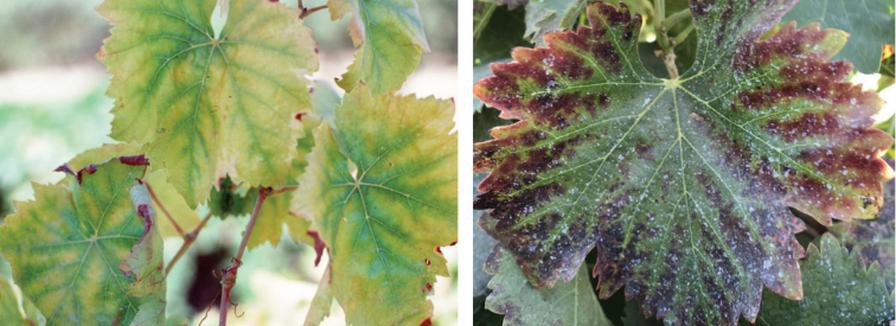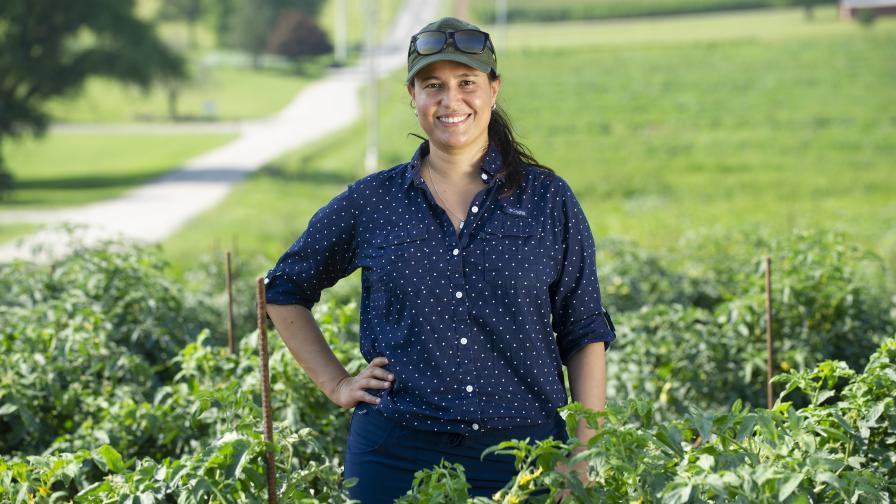Keys To Managing Potassium in Vineyards

Severe potassium deficiency symptoms can be seen in both white and red grape varieties.
Photos: L.P. Christensen and G. Zhuang, UCCE
Potassium (K) is an essential nutrient that fulfills critical functions including enzyme activation, osmotic adjustment, turgor generation, cell expansion, regulation of membrane electric potential, and pH homeostasis. Large quantities of K are needed, so it is considered a “macronutrient.” Potassium is one of the most abundant elements on Earth, and most soils contain 0.5 to 2.5% K, yet only a relatively small percentage of soil K is available in ion form, adsorbed, and exchangeable at the surface of soil colloids, or as a solute of the soil solution.
Soil moisture affects K availability to plants. Potassium ions diffuse through soil via films of water surrounding soil particles. Diffusion is a relatively slow process, and rapidly growing vines can deplete K in the soil solution surrounding roots. Drying soil also reduces plant-available K by reducing the thickness of the water films around soil particles, which increases the diffusion path lengths. Drying also increases K fixation in soils, further restricting K availability to plant roots.
UPTAKE AFTER BUDBREAK
Potassium absorbed from the soil is sent to leaves via xylem. In leaves, K+ (monovalent cation) is loaded into phloem for transport to other parts of the plants as needed, including the roots. This cycle distributes K to the plant tissues that need it and provides feedback to the roots on plant demand for K+. In grapevines, most of the annual uptake of K occurs between budbreak and veraison. Before bloom, most of the K is sent to stems and leaves. After bloom, the fruit develop a strong demand for K, and after veraison, fruit demand may exceed the roots’ uptake of K from soil. Up to 50% of the K needed by ripening fruit may be translocated from other organs, including roots, trunk, leaves, and stems.
The translocation of K from the leaves may result in foliar K deficiency symptoms, which are typically first noticed in mid-summer on leaves in the middle of a shoot. Potassium-deficient leaf blades develop a glossy appearance, bronze discoloration, and chlorotic (yellow) leaf margins, with an indistinct transition to the greener center of the blade. The leaf margin may become red or purple colored in red or black varieties, respectively. Leaf blades with severe deficiencies become “cupped” with dry margins that curl upward or downward. Shoot growth on K-deficient vines is restricted, and leaf fall may be premature. Potassium-deficient vines may have fewer, smaller, and tighter clusters, with unevenly colored and smaller berries.
Tissue analysis is useful for monitoring the K status of vines. Bloom-time petiole samples collected from opposite a cluster should have K levels >1.5%; values between 1% and 1.5% are considered marginal and should be retested at veraison, at which time petioles from recently expanded leaves should have >0.8% K. Vines with particularly high crops should also be retested at veraison.
WATCH FOR DEFICIENCY
Table grapes in San Joaquin Valley accumulated between 150 and 330 pounds of K per acre in their annual growth (leaves, stems, and fruit), with 55 to 65% of that allocated to clusters. There were 2.64 to 5.21 pounds of K in a ton of grapes, depending on the variety. Replacing the K in harvested fruit could be considered for maintenance applications, though additional K is likely needed as some applied K could be fixed in some soils. Determining the K needed to correct or prevent deficiency is complicated by other variables, including soil type, depth, and moisture content, rootstock genotype, and vine age. Deficit irrigation and drought can induce K deficiency, especially on K-fixing soils. Rootstocks with V. berlandieri heritage, including 1103P, do not take up K as readily as rootstocks derived from V. champinii, such as Freedom and Harmony. The smaller root system of younger vines might make them more susceptible to K deficiency.
Nitrogen, magnesium (Mg), and calcium (Ca) fertilizers can also affect K uptake. Application of K without sufficient N may lead to decreased N content. Nitrate tends to promote K accumulation, whereas ammonium may interfere with the diffusion of K from clay lattice and compete with K for uptake by roots. Application of Ca or Mg can reduce K uptake, but not usually to the point that critical values are seriously affected.
In furrow-irrigated vineyards, K requires deep placement in a concentrated band close to the vine, an application in winter facilitates movement of K into the root zone. Fertigation is more efficient than banded applications, enabling lower rates to be used, especially in K-fixing soils.
Potassium fertigation is done in spring, before veraison. Table grape growers in the San Juaquin Valley commonly “spoon feed” K through the drip system, applying relatively small amounts (10 to 13 pounds K/acre) weekly, for five to 10 weeks before veraison.
Because K is not substantially leached below the root zone under drip irrigation, a single application may be just as efficient as multiple applications. Early research on foliar application with KNO3 showed few or no effects on grapevines, possibly because of the low rates used (0.5%); higher rates caused phytotoxicity. However, foliar applications with similar rates of K2SO4 or KH2PO4 increased anthocyanin content of table and wine grapes. Foliar applications of K salts, including potassium sorbate, potassium bicarbonate, and glycine-complexed potassium, have also been found to increase berry soluble solids, by causing the berries to desiccate. Foliar K applications could increase berry and wine pH, which might be undesirable.










